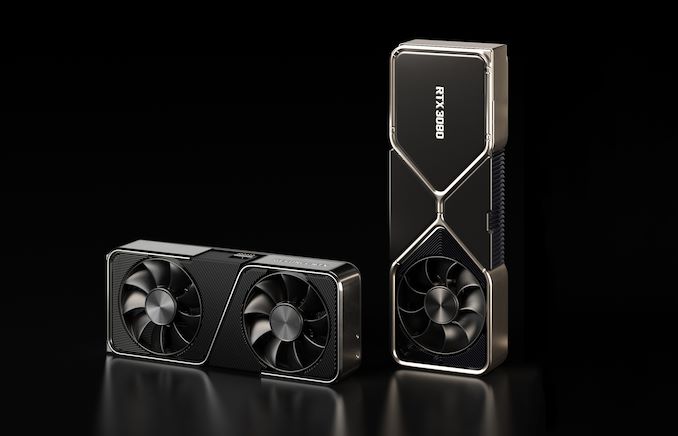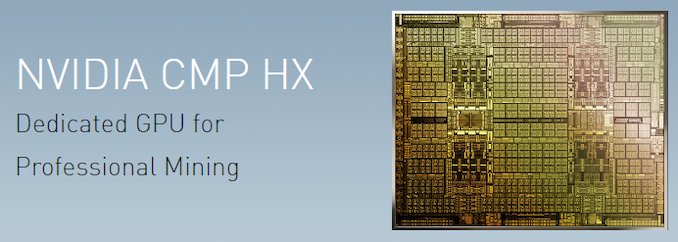NVIDIA To Extend Ethereum Throttle to GeForce RTX 3080, 3070, & 3060 Ti “LHR” Cards
by Ryan Smith on May 18, 2021 5:00 PM EST
Continuing their ongoing efforts to limit the Ethereum mining performance of their GeForce video cards – and thus make them less enticing for miners – NVIDIA today has announced that they are bringing their cryptocurrency hash limiter to additional GeForce cards. Already a fixture on the vanilla GeForce RTX 3060 since it’s launch, NVIDIA has begun incorporating their hash limiting technology and its associated security stack into newly manufacture red GeForce RTX 3080, 3070, and 3060 Ti cards. The new cards will appear on shelves later this month, and will carry the “LHR” branding to differentiate themselves from the first-generation, unthrottled cards.
We’ve been covering the ongoing matter of NVIDIA and Ethereum mining for several months now, as the company has worked to deal with the unexpected (and largely unmanageable) surge in video card demand that has come as the price of Ethereum tokens has exploded. Even with the cryptocurrency down almost 20% in a week, Ethereum mining is still quite profitable on NVIDIA cards. Which in turn has contributed to an unprecedented and sustained spike in demand for video cards that NVIDIA (and AMD) are unable to meet.
In order to make their cards less useful to miners – and to try to shift shipments back to gaming customers – NVIDIA began rolling out an Ethereum hash limiter, starting with their GeForce RTX 3060 card back in February. NVIDIA’s hash limiter throttles a card’s Ethereum mining performance to 50% of its native rate, reducing (though not eliminating) a card’s usefulness and profitability for mining. Overall, this initial rollout did not go quite as planned thanks to an unforced error on NVIDIA’s part that partially disabled the throttle. But it clearly has not deterred NVIDIA as they have continued to refine their hash limiter and, now, are expanding it to other cards.
To that end, NVIDIA is adding the hash limiter to new GeForce RTX 3080, 3070, and 3060 Ti cards. As always, the company isn’t sharing much in the way of technical details, but it looks like this is the same hash limiter that is going into revised GeForce RTX 3060 cards, which began shipping in the middle of this month. Key among that technology is an updated vBIOS that requires a minimum driver version – 466.71 in the case of hash-limited 3080/3070/3060Ti cards – preventing their use with older drivers that lack throttling capabilities. Through the combination of the revised vBIOS and drivers, NVIDIA in turn is able to detect and limit the Ethereum hashing performance of these new cards.
| NVIDIA GeForce RTX 30 Series Release Info | ||||
| Original | LHR/Revised | |||
| RTX 3090 | 09/2020 | - | ||
| RTX 3080 | 09/2020 | Late May | ||
| RTX 3070 | 10/2020 | Late May | ||
| RTX 3060 Ti | 12/2020 | Late May | ||
| RTX 3060* | 02/2021 | Mid May | ||
Meanwhile, these new cards will be receiving additional labeling to differentiate them from the original generation of unthrottled cards. Calling this throttling feature “Lite Hash Rate”, or “LHR”, according to NVIDIA there will be LHR branding/information put on the relevant product boxes as well as on retail websites. Ostensibly, this is to communicate to buyers that the cards are hash-limited, but at the same time it’s likely that this branding is required for legal reasons as well, as NVIDIA is introducing an additional limitation that was not present on the original generation of cards.
This is a slightly different branding strategy from how they’ve handled the RTX 3060, owing in large part to the RTX 3060 shipping with a hash limiter from day one. In the case of the RTX 3060, even when NVIDIA began shipping revised cards earlier this month no branding changes were needed, and few (if any) RTX 3060 cards mention being hash rate limited. With that said, we’ve already seen Gigabyte accidentally publish and then pull RTX 3060 product pages that mention LHR as well, so we may see NVIDIA’s board partners use the LHR branding across their entire GeForce product lines in order to be consistent.
Ethereum performance aside, NVIDIA says that the upcoming LHR GeForce cards are functionally identical to the original generation GeForce 30 series cards as far as compute and gaming performance go. For our part, we have not seen the Ethereum throttle trigger in other use cases on the RTX 3060, so we’re not expecting different behavior on the more powerful GeForce cards. For better or worse, Ethereum has a very distinct workload (memory bandwidth bound and comprised almost entirely of random-access operations), so it’s rather easy to tell apart from games and even other compute workloads.
Finally, the GeForce RTX 3090, NVIDIA’s flagship GeForce 30-series card, will be the odd man out as far as the LHR changes go. NVIDIA is not issuing an LHR version of that card, owing to the fact that the $1500 MSRP card’s rate of return isn’t nearly as high as the likes of the RTX 3080 and RTX 3060 Ti, making it relatively less popular with miners.
As with the launch of throttled RTX 3060 cards, NVIDIA says that they are doing this to better ensure that GeForce cards make it to gamers, as opposed to being conscripted into mining farms. Overall, this is part of a larger overall NVIDIA strategy to respond to the rise of Ethereum and the resulting crush of demand in the short term and the long term. Ideally, NVIDIA would like to shift Ethereum miners over to their CMP series of dedicated mining cards, which fetch higher prices don’t (directly) compete with GeForce cards. Meanwhile, reducing the number of GeForce cards going into mining means those cards don’t boomerang back on to the second-hard market once the Ethereum mining bubble does pop, thereby avoiding the kind of supply glut that lead to the crypto-hangover of 2018.
Wrapping things up, the revised LHR GeForce 30-series cards are already in production, and will begin shipping to retailers later this month. Given how quickly video cards of all flavors have been selling, the remaining unthrottled cards should quickly sell out. At which point we expect that NVIDIA’s anti-Ethereum measures will truly be put to the test, as miners will be facing their own supply shortages.
Source: NVIDIA











47 Comments
View All Comments
quorm - Tuesday, May 18, 2021 - link
Lol, how insightfulSamus - Tuesday, May 18, 2021 - link
They're make more cards alright. Mining cards. For 2x the price. This is more a marketing move than a favor to gamers, but it has the benefit of still helping gamers. My guess is the limited-hash-rendering cards will not only be in stock but likely sell at MSRP as miners will be better off going with unnerfed cards of mining-based cards. The economics won't neccessarily work in their favor if nVidia orchestrates this how I think they are going to, but it'll probably be a wash regarding hardware costs. The benefit of mining-oriented hardware will obviously be they need less physical hardware and likely lower energy cost: instead of 6x3080's @50% efficiency, they can get 3x mining cards on the same GPU @100% efficiency.The entire thing is a joke. I can't wait til the day we look back on how much energy we blew searching for monopoly money because some people 'said' it was valuable.
Gigaplex - Tuesday, May 18, 2021 - link
How do you propose they make more cards if the fabs are overbooked and supply constrained? They're making as many as they can.Spunjji - Wednesday, May 19, 2021 - link
"That reminds me of the long dead communism"What? How?!
Silver5urfer - Tuesday, May 18, 2021 - link
Gimped GPUs for more price what else, Ngreedia. Esp the fact how CMP GPUs are horrible in their performance / power consumption / price no dumb idiot would buy them, the Antiminer E9 is the way to go for so called "Professional Miners" that Nvidia is using. As it crushes the bs GPUs to oblivion.Nvidia only was interested int this until they had tons of cash from Q4 2020 where they posted insane profits but little to none PC market userbase, they knew it all along how Ampere is going to rake the Crypto, but they didn't care then because money speaks, now that they got enough and want to save their ass when the bubble bursts so their constant income will stop. Primary reason they are selling the castrated parts to that people can only do what nvidia tells them to do.
Still 1/2Hash rate won't fix the supply and pricing problems, so many are already vested in the ecosystem they will simply hoard the same GPUs at this point even AMD RDNA2 cards are used in mining even when they are bad vs Radeon 7 of GCN and Nvidia's Ampere. So it doesn't matter, if Nvidia really cared they would have either pushed Zero Hash Rate or no limits.
The market will show how this move ends up. As for the posts making about the miners will beat and all, think again. The vBIOS on the Pascal and up GPUs are locked hard, you cannot unlock them at all not even modders can do a custom vBIOS the only exceptions are engg vBIOSes or those XOC vBIOSes, still they have a lot of limitations.
Gigaplex - Tuesday, May 18, 2021 - link
The Antminer is likely a waste of money, as ETH profitability is expected to drop very soon (EIP 1559) and then mining will cease entirely anyway (ETH 2.0 Proof of Stake).ABR - Wednesday, May 19, 2021 - link
AFAIK proof of stake has nowhere been shown viable in cryptosecurity ecosystems, and that's why it isn't used anywhere major despite being talked about for years. I'm not expert enough to say why, but I guess the end problem is providing sufficient financial motivation for the network compute providers when mining isn't there. Ethereum continues to experiment around in this space, which is what EIP 1559 is about (integrating transaction fees more effectively into the system).bji - Friday, May 21, 2021 - link
I'm running a Solana validator. I find that there is sufficient financial reward. Many people do (well, many as in hundreds). A lot of people complain that it isn't accessible enough; more people want to do it. But at the moment the entry barrier costs and required stake to become profitable make it a very tough row to hoe for new entrants.Achaios - Wednesday, May 19, 2021 - link
ETH was supposed to have gone "proof of stake" 5 or 6 years ago and every single year hence."Proof of stake" is just baloney powerless gamers post on msg boards imagining it as the nemesis of ETH while Miners laugh all the way to the bank and keep mining.
bji - Friday, May 21, 2021 - link
I'm a Proof of Stake validator and I'm laughing all the way to the bank. I am quite certain I make more off of my validator than the vast majority do off of eth mining.These topics are complex and your over simplified and under informed analysis don't really help anything.